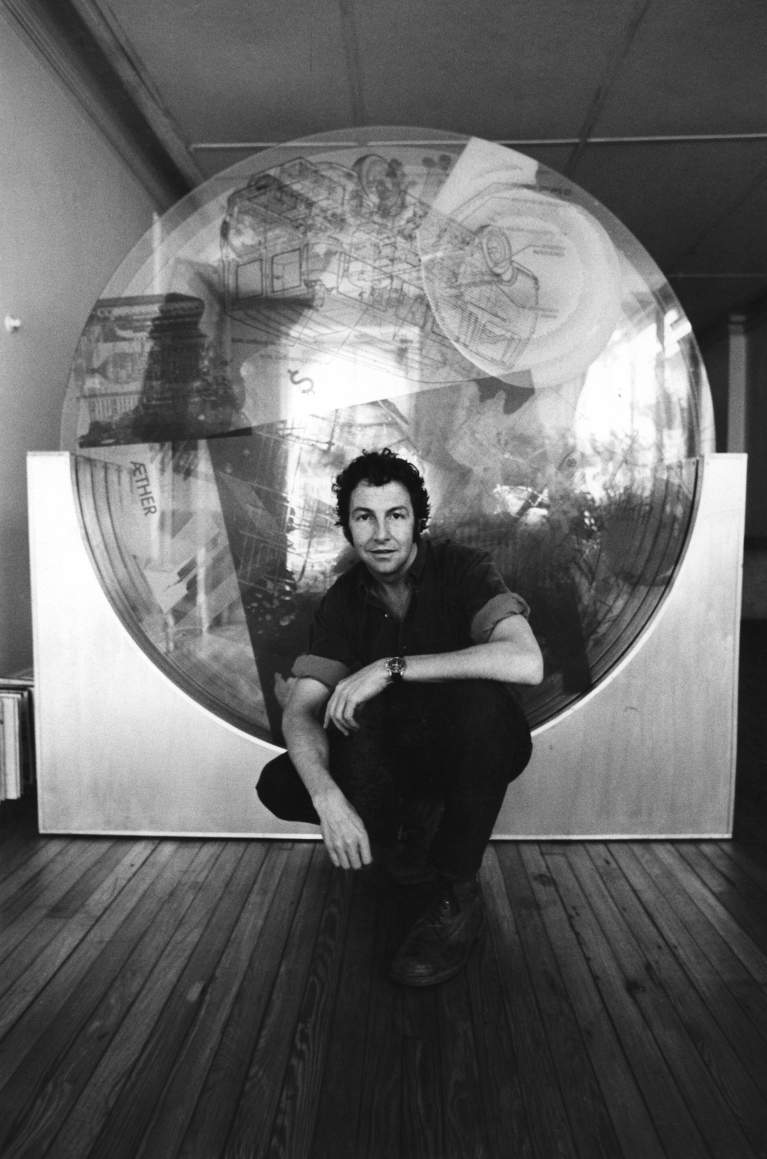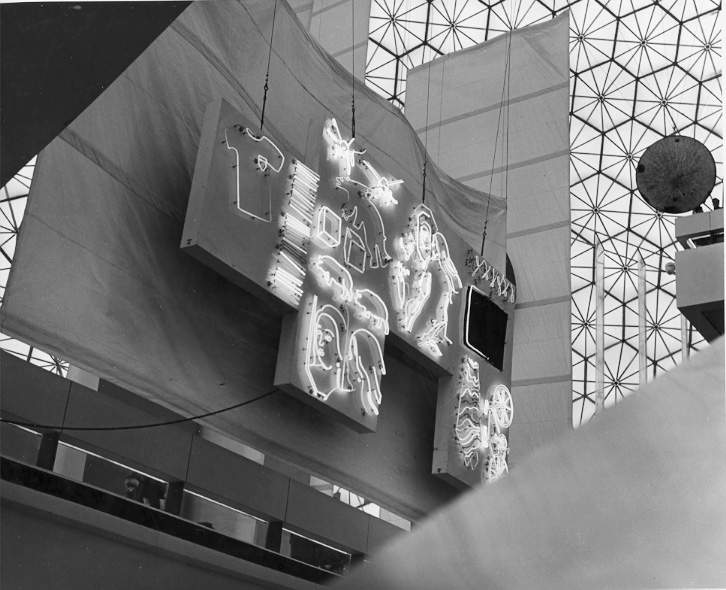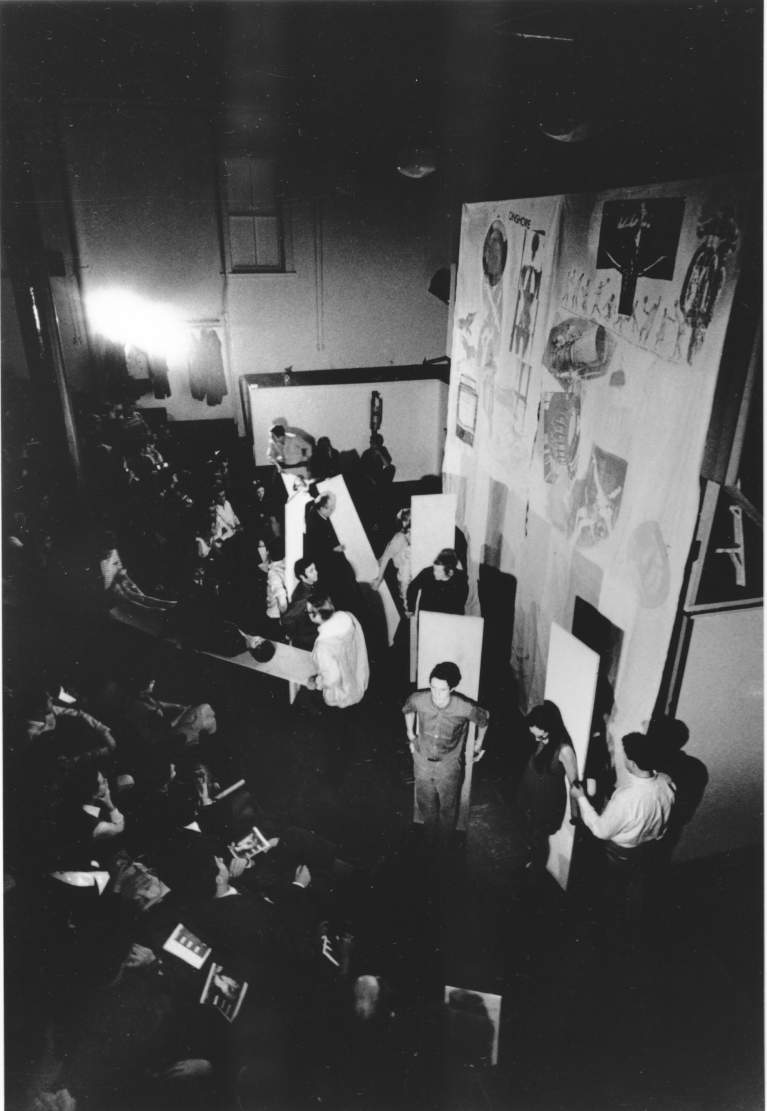1960-69
1967
Creates two untitled transfer drawings for the book In Memory of My Feelings by Frank O’Hara. One drawing is overlaid with O’Hara’s poem “A Step Away from Them”; both are gifted to the Illustrated Book Collection of the Museum of Modern Art, New York. The limited-edition volume includes photo-offset reproductions of forty-six drawings by Rauschenberg, Jasper Johns, Willem de Kooning, Roy Lichtenstein, Robert Motherwell, Barnett Newman, Claes Oldenburg, Niki de Saint Phalle, and other artists.
Designs book cover for Poems by John Giorno.1
January 15: Experiments in Art and Technology (E.A.T.), New York, publishes first issue of E.A.T. News, designed by Rauschenberg. Subsequent issues of their newsletter will be published later this year on June 1, November 1, and December 20, and the following year on March 18.
February–April: Begins working relationship with print workshop Gemini G.E.L., Los Angeles, making Booster and 7 Studies (all 1967). Booster, at 6 feet in height, is the largest hand-pulled lithograph to date. The work contains a full-size reproduction of an X-ray of Rauschenberg, requiring two lithography stones connected by a honeycomb structure. To create the lithograph, Rauschenberg uses a new transfer technique of photomechanically reproducing newspaper and magazine images onto printing plates. The project, which incorporates silkscreen and lithography, represents Gemini G.E.L.’s first activity in combination printing.
March: Participates in Art in Process, Finch College Museum of Art, New York. Exhibits Short Circuit (1955).
March 7: Rauschenberg performs in Outskirts, which he created for the event Body, organized by Jon Gibson and coordinated by Irving Sandler, Loeb Student Center, New York University. The performers crawl along the stage, their heads poking through holes in a white sheet onto which Rauschenberg’s film Canoe (1966) is projected. Also performs in John Giorno’s Raspberry.
Early spring: Makes Revolver series, six sculptures consisting of silkscreened ink on five rotating Plexiglas discs, each one mounted behind the other in no particular order, with electric motors. By using a control box, the viewer rotates the discs and creates a kaleidoscopic effect with the images. The works will be featured in the broadcast “The Walls Come Tumbling Down” on the CBS television program Eye on New York.
April 28–October 27: Participates in American Painting Now, organized by Alan Solomon for Expo ’67, Montreal, U.S. Pavilion. Exhibits Green Shirt (1965–67), a multicolored painting of neon and enameled metal installed inside R. Buckminster Fuller’s geodesic dome. The work, commissioned in 1965, contains motifs found in Rauschenberg’s silkscreen paintings such as Peter Paul Rubens’s Venus in Front of the Mirror (1614–15), insects, and a diagram of cubes. The exhibition will travel to the Institute of Contemporary Art, Boston.
May 13–June 10: Exhibits Revolvers, Leo Castelli, New York.
May 26: Rauschenberg and artists Jack Levine and Andrew Wyeth are featured in a broadcast of the NBC television program The American Image, a documentary series exploring American life as depicted by artists from colonial to contemporary times, focusing on four broad themes: the land, industrialization and cities, patriotism and politics, and the people.
June 6–8: Giant Model Airplanes, an exhibition and auction organized by Christie’s of London to benefit E.A.T., is held in Rauschenberg’s Lafayette Street studio, New York. The works, created for donation by ONCE Group, Ann Arbor, Michigan, are precisely scaled with detailed enlargements of stick-and-tissue models of vintage aircraft.
[Summer]: Works, along with Alex Hay, Deborah Hay, and Steve Paxton, with students at Port Townsend Theater Workshop, Washington.
July 5–31: Exhibition of Booster and 7 Studies, Douglas Gallery, Vancouver.
October 10: Press conference and exhibition of artworks involving technology, including Oracle (1962–65), held at Rauschenberg’s Lafayette Street studio, to formally introduce E.A.T. to the public. Speeches are delivered by Rauschenberg; Warren Brodey, director of M.I.T. Science Camp; Ralph Gross, President, Commerce and Industry Association; U.S. Senator Jacob Javits (R-N.Y.); Herman Kenin, President, American Federation of Musicians; Theodore Kheel, President, American Foundation on Automation and Employment, and labor mediator; Robert Morris; and John Pierce, Executive Director, Bell Telephone Laboratories.
October 24: Participates in Elaine Sturtevant’s Relâche, School of Visual Arts, New York, a (non)performance based on Francis Picabia and Erik Satie’s 1924 ballet of the same name. Sturtevant’s “performance” consists of a sign on the theater door announcing its cancellation (relâche) and a photograph entitled Relâche, which imitates a Man Ray photograph of a scene from Picabia’s play Cinésketch (December 31, 1924) in which Marcel Duchamp and Brogna Perlmutter (Francine Picabia) appeared naked as Adam and Eve in a tableau vivant of Lucas Cranach’s Adam and Eve (1533). In Sturtevant’s photograph, Rauschenberg poses nude as Duchamp posing as Adam (with false beard and fig leaf) and she poses as Eve.2
October 24–December 2: Participates in Protest and Hope: An Exhibition of Contemporary American Art, New School Art Center, New York. Exhibits silkscreen painting, Caller (1965). Forty-three artists, including Rauschenberg, Red Grooms, Elaine de Kooning, George Segal, and Andy Warhol, contribute works relating to the show’s antiwar and civil-rights themes.
October 29: Receives honorary degree, Doctor of Humane Letters, Grinnell College, Iowa. Meets Martin Luther King, Jr., who has been temporarily released from prison to accept an honorary degree from the college.
November 9–December 17: Participates in Kompas 3: Schilderkunst na 1945 uit New York (Paintings after 1945 in New York), Stedelijk Museum, Amsterdam. Exhibits Charlene (1954), Pilgrim (1960), and Wall Street (1961). The exhibition will travel to Frankfurter Kunstverein (as Kompass New York: Malerei nach 1945 aus New York).
November 10, 19: Rauschenberg performs in Urban Round, which he creates for Fall Gallery Concerts, School of Visual Arts, New York. The work is performed by him, Mel Bochner, Sandy Daley, Simone (Whitman) Forti, Susan Hartnett, Deborah Hay, Billy Klüver, Brice Marden, Julie Martin, Steve Paxton, Yvonne Rainer, Christopher Rauschenberg, Dorothea Rockburne, Annina Weber, John Weber, and David White. A silkscreen painting is used as the backdrop against which performers read aloud from newspapers while being carried on brightly colored wood boards. Each performer reads an article and then descends to help carry a new reader.
December 8: Time magazine features cover designed by Rauschenberg using film stills from Bonnie and Clyde to accompany the article “Hollywood: The Shock of Freedom in Films.”


 Rauschenberg in his Lafayette Street studio with Revolver VI (1967), New York, ca. 1967. Photo: Maurice Hogenboom
Rauschenberg in his Lafayette Street studio with Revolver VI (1967), New York, ca. 1967. Photo: Maurice Hogenboom
 Rauschenberg’s Green Shirt (1967) on view in American Painting Now, R. Buckminster Fuller’s geodesic dome, United States Pavilion, Expo 67, Montreal. Photo: Shunk-Kender © J. Paul Getty Trust
Rauschenberg’s Green Shirt (1967) on view in American Painting Now, R. Buckminster Fuller’s geodesic dome, United States Pavilion, Expo 67, Montreal. Photo: Shunk-Kender © J. Paul Getty Trust

 Rauschenberg’s Urban Round, Fall Gallery Concerts, School of Visual Arts, New York, November 1967. Photo: Peter Moore © Barbara Moore/Licensed by VAGA, NY
Rauschenberg’s Urban Round, Fall Gallery Concerts, School of Visual Arts, New York, November 1967. Photo: Peter Moore © Barbara Moore/Licensed by VAGA, NY
